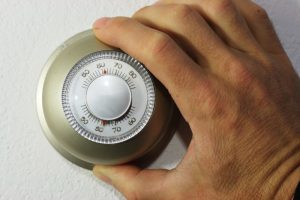 It’s hot here in Texas this August! It’s been a hot summer in general, and you’ve probably gotten a huge amount of work out of your air conditioning system already this year. With the outdoor thermometer soaring into the red, how are you coping with it inside your home?
It’s hot here in Texas this August! It’s been a hot summer in general, and you’ve probably gotten a huge amount of work out of your air conditioning system already this year. With the outdoor thermometer soaring into the red, how are you coping with it inside your home?
If your answer is “I keep turning the thermostat down lower and lower,” you’re actually wasting money and putting more stress on your air conditioning system while not receiving any better comfort. We know how tempting it is to drop the thermostat’s setting to 60°F (often the lowest setting) on a roasting hot day. But there are some serious problems with this.
A Thermostat Is a Switch, Not a Throttle
“More cooling! More cooling!” If you’re imagining that as you turn the thermostat down, the AC huffs like a coal-burning engine fed with more coal—well, that’s not how it works. When you turn down the thermostat, all it does is set a different target temperature for the air conditioner to reach. When the thermostat’s temperature sensors detect the temperature has been reached, the thermostat switches off the fans and compressor. The thermostat is a switch—“on” or “off”—not a throttle that can ramp power up and down. So when you drop the thermostat as low as possible, you’re only keeping the AC running longer, not giving you a higher cooling output or a faster output.
The Heat Gain Problem
Why does a hot day make your home get hot? Because the heat enters your home through the walls, windows, and gaps in insulation: heat moves from an area of higher concentration to an area of lower concentration. Slowing down this heat gain is one of the best ways to keep your home cool. Good insulation is an important part of it—but you can also slow down the heat gain by keeping the temperature of the house closer to the temperature of the outdoors. The closer the two temperatures, the slower the heat gain. If you drop the temperature down to something like 60°F, the house will gain heat faster and force the air conditioner to keep working.
What You Can Learn From This
So taking these two facts, you should set your thermostat at a higher temperature—one you find comfortable—and keep it steadily there during the day. You’ll slow down heat gain and prevent the AC from running continually when it isn’t necessary.
What temperature is ideal? This differs depending on the household. The Department of Energy recommends 78°F during the day when people are in the home, with a setback temperature of 8°F at night or when people are away. It’s easy to handle this with a programmable thermostat. You may find 78°F not comfortable, in which case you can set it lower and then raise it one degree per day until you become acclimatized to the higher setting.
If it turns out you need air conditioning repair in Katy, TX, depend on us. We believe that comfort can cost less, and we’ll help you enjoy the best possible cooling while also saving money.

